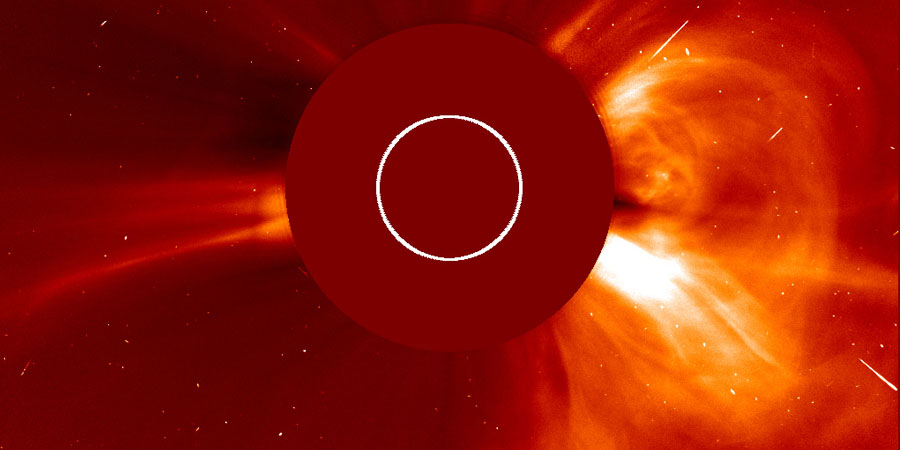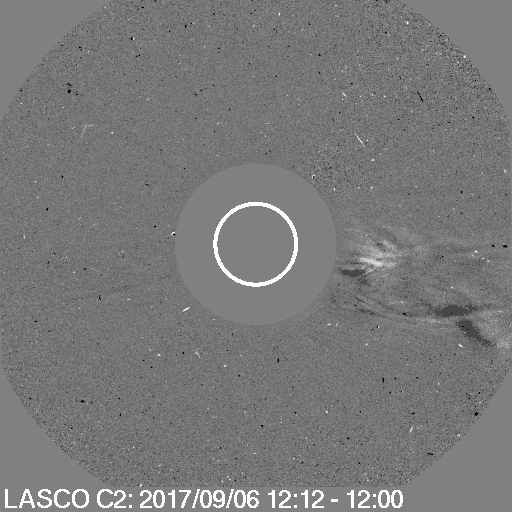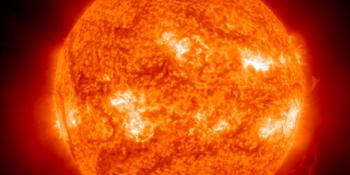X9.3 earth-directed coronal mass ejection
Wednesday, 6 September 2017 21:09 UTC

The wait is over. We finally have a complete set of SOHO/LASCO coronagraph images from today's memorable X9.3 solar flare. If you missed today's space weather events be sure to read this news article before you continue reading here.
As most of you probably already suspected, the eruption was very broad and the plasma cloud indeed has an earth-directed component. The animation below shows you the coronal mass ejection as seen by the SOHO LASCO C2 and C3 coronagraphs.

⇧ Animation: SOHO LASCO C2 and C3 difference footage showing the X9.3 coronal mass ejection as it is ejected into space.
We see a clear asymmetrical full halo coronal mass ejection with the bulk of the CME heading well towards the south-east. It does seem that sunspot region 2673 has rotated a bit too far to the west already for a real head on collision with the plasma cloud. Nonetheless there is a clear earth-directed component and an impact is likely to occur.
We estimate the bulk speed of this coronal mass ejection to be in the 1.700 to 1.800km/s range which is fairly fast but the flanks do seem quite a bit slower which makes this a very tricky situation. We also need to factor in the M5.5 CME which is still on it's way as that will also affect how much the X9 CME will decelerate. All in all a very complex situation but we estimate that a 42 hour transit from the Sun to Earth seems plausible meaning the plasma cloud could arrive at Earth around 06:00 UTC this Friday, 8 September 2017. As always there is a healthy amount of uncertainty with these impact times but it should give a rough idea when to expect enhanced geomagnetic conditions. It will be interesting to see what NOAA's ENLIL model is going to predict.
While the solar flare was strong, we doubt it's coronal mass ejection is going to cause a truly large (G4 or G5) geomagnetic storm due to the reasons stated above. We suspect that moderate G2 geomagnetic storm conditions will be possible on 8 September with a chance of isolated periods with strong G3 storm conditions.
Thank you for reading this article! Did you have any trouble with the technical terms used in this article? Our help section is the place to be where you can find in-depth articles, a FAQ and a list with common abbreviations. Still puzzled? Just post on our forum where we will help you the best we can!
Latest news
Latest forum messages
Support SpaceWeatherLive.com!
A lot of people come to SpaceWeatherLive to follow the Sun's activity or if there is aurora to be seen, but with more traffic comes higher server costs. Consider a donation if you enjoy SpaceWeatherLive so we can keep the website online!

Space weather facts
| Last X-flare | 2025/01/04 | X1.85 |
| Last M-flare | 2025/01/09 | M1.1 |
| Last geomagnetic storm | 2025/01/04 | Kp5 (G1) |
| Spotless days | |
|---|---|
| Last spotless day | 2022/06/08 |
| Monthly mean Sunspot Number | |
|---|---|
| December 2024 | 154.5 +2 |
| January 2025 | 144.5 -10 |
| Last 30 days | 151.1 +32.8 |


